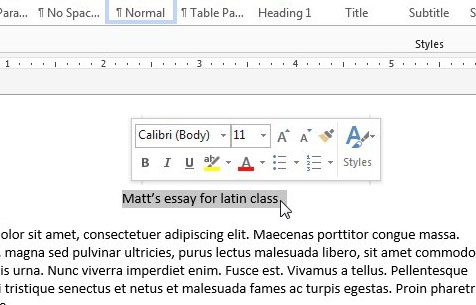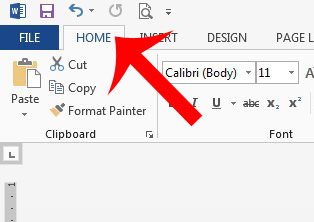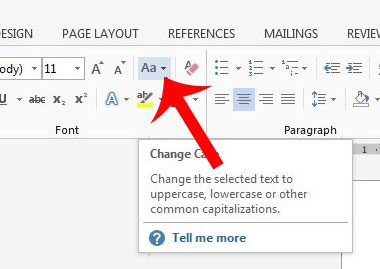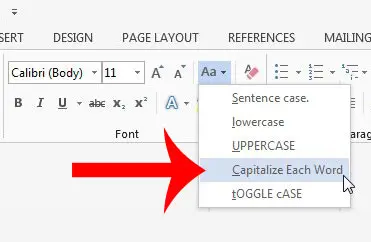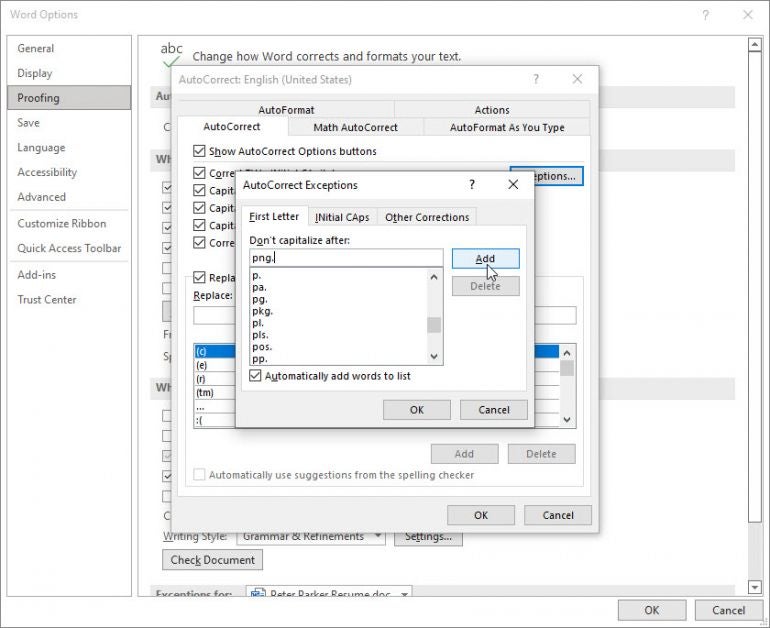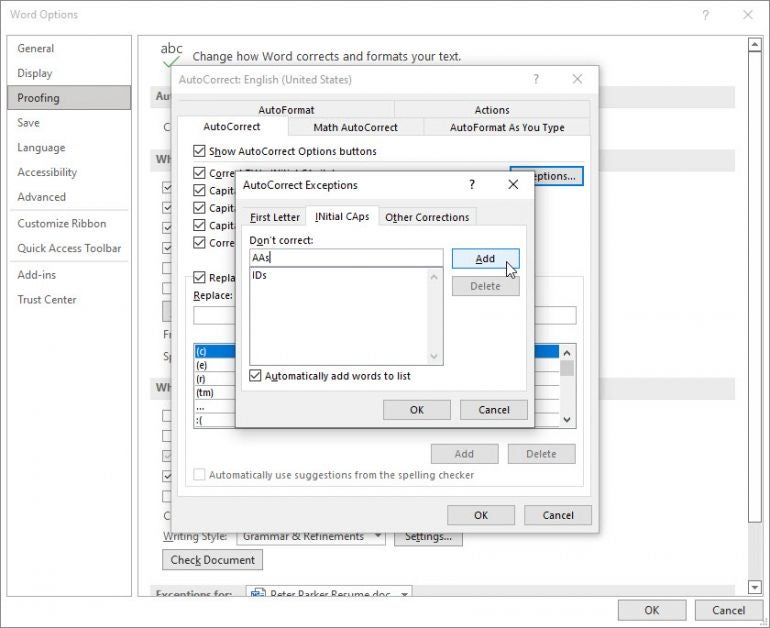You can change the capitalization, or case, of selected text in a document by clicking a single button on the Home tab called Change Case.
Change case
To change the case of selected text in a document, do the following:
-
Select the text for which you want to change the case.
-
Go to Home > Change case
.
-
Do one of the following:
-
To capitalize the first letter of a sentence and leave all other letters as lowercase, click Sentence case.
-
To exclude capital letters from your text, click lowercase.
-
To capitalize all of the letters, click UPPERCASE.
-
To capitalize the first letter of each word and leave the other letters lowercase, click Capitalize Each Word.
-
To shift between two case views (for example, to shift between Capitalize Each Word and the opposite, cAPITALIZE eACH wORD), click tOGGLE cASE.
Tips:
-
To apply small capital (Small Caps) to your text, select the text, and then on the Home tab, in the Font group, click the arrow in the lower-right corner. In the Font dialog box, under Effects, select the Small Caps check box.
-
To undo the case change, press CTRL+ Z.
-
To use a keyboard shortcut to change between lowercase, UPPERCASE, and Capitalize Each Word, select the text and press SHIFT + F3 until the case you want is applied.
-
See also
Insert a drop cap
Choose AutoCorrect options for capitalization
Change case
To change the case of selected text in a document, do the following:
-
Select the text for which you want to change the case.
-
Go to Home > Change case
.
-
Do one of the following:
-
To capitalize the first letter of a sentence and leave all other letters as lowercase, click Sentence case.
-
To exclude capital letters from your text, click lowercase.
-
To capitalize all of the letters, click UPPERCASE.
-
To capitalize the first letter of each word and leave the other letters lowercase, click Capitalize Each Word.
-
To shift between two case views (for example, to shift between Capitalize Each Word and the opposite, cAPITALIZE eACH wORD), click tOGGLE cASE.
Tips:
-
To apply small capital (Small Caps) to your text, select the text, and then on the Format menu, select Font, and in the Font dialog box, under Effects, select the Small Caps box.
Small Caps shortcut key: ⌘ + SHIFT + K
-
To undo the case change, press ⌘ + Z .
-
To use a keyboard shortcut to change between lowercase, UPPERCASE, and Capitalize Each Word, select the text and then press fn+ SHIFT + F3 until the style you want is applied.
-
See also
Insert a drop cap
Choose AutoCorrect options for capitalization
PowerPoint for the web supports changing case. See the procedure below.
Word for the web doesn’t support changing case. Use the desktop application to open the document and change text case there, or else you can manually change the casing of text in Word for the web.
-
Select the text you want to change.
-
Go to Home > More Font Options > Change case.
-
Choose the case you want to use.
To use a keyboard shortcut to change between lowercase, UPPERCASE, and Capitalize Each Word, select the text and press SHIFT + F3 until the case you want is applied.
Contents
- 1 How do you capitalize without retyping in word?
- 2 What is Capitalise each word?
- 3 Why is shift F3 not working?
- 4 How do I make text all caps?
- 5 How do you capitalize the first character of each word in a string?
- 6 How do you automatically capitalize the first letter in word?
- 7 How do I capitalize the first letter in Windows 10?
- 8 How do you make each word in a text start with a capital letter CSS?
- 9 How do you capitalize the first letter of each word in C++?
- 10 What are the 10 rules of capitalization?
- 11 What does the F10 key do?
- 12 What does Alt F4 do in Word?
- 13 What is L Ctrl?
- 14 How do you do small caps in word Online?
- 15 How do you capitalize all letters in word on a Mac?
- 16 How do you do small caps in word Mac?
- 17 Is uppercase method Java?
- 18 How do you capitalize the first letter of a word in a string in Java?
- 19 Which method will convert the first letter of each word in a string to a capital letter in Python?
- 20 How do you capitalize on a laptop?
How do you capitalize without retyping in word?
Select the text you want to change the case of, using your mouse or keyboard. On the Home tab of the Ribbon, go to the Fonts command group and click the arrow next to the Change Case button.
What is Capitalise each word?
Capitalization (American English) or capitalisation (British English) is writing a word with its first letter as a capital letter (uppercase letter) and the remaining letters in lower case, in writing systems with a case distinction. The term also may refer to the choice of the casing applied to text.
Why is shift F3 not working?
Shift F3 Not Working When The “Fn” Key Is Locked
2.Fn + Caps Lock. Fn + Lock Key (A keyboard key with only a lock icon on it) Press and Hold the Fn key to enable/disable.
How do I make text all caps?
Selecting a case
- Highlight all the text you want to change.
- Hold down the Shift and press F3 .
- When you hold Shift and press F3, the text toggles from sentence case (first letter uppercase and the rest lowercase), to all uppercase (all capital letters), and then all lowercase.
How do you capitalize the first character of each word in a string?
To capitalize the first character of a string, We can use the charAt() to separate the first character and then use the toUpperCase() function to capitalize it.
How do you automatically capitalize the first letter in word?
Enable/Disable Auto Capitalization in Word 2016 & 2013
- While working in Word, select the “File” menu and choose “Options“.
- Select “Proofing” and then select the “AutoCorrect Options…” button.
- Here you can check the boxes to customize what you want Word to automatically capitalize.
How do I capitalize the first letter in Windows 10?
Auto-capitalization is designed to work with touch keyboards. If you are using a physical keyboard, using the Shift + Letter key is much easier than toggling the Caps Lock button everytime you want to input a capitalized letter.
How do you make each word in a text start with a capital letter CSS?
To make a block of text have all capital letters, use text-transform: uppercase in your CSS selector: text-transform: uppercase; The text-transform property accepts three possible values: uppercase: Sets each word to uppercase in a text element.
How do you capitalize the first letter of each word in C++?
Algorithm:
- Initialize the variables.
- Accept the input.
- Calculate the length of input.
- Initialize a for loop.
- Convert first and last index of the string to uppercase using toupper() function.
- Check for space.
What are the 10 rules of capitalization?
What are the 10 rules of capitalization?
- Capitalize the first word of a sentence.
- Capitalize proper nouns and names.
- Capitalize the majority of titles.
- Capitalize events and periods.
- Capitalize “I” as a pronoun.
- Capitalize any locations and direct addresses.
- Capitalize family relationships.
What does the F10 key do?
F10. The F10 key will open the menu bar or similar options within most open Microsoft apps. Hitting Shift + F10 on a highlighted file, link or icon will act in the same way as a right-click.
What does Alt F4 do in Word?
Alt + F4 is a Windows keyboard shortcut that completely closes the application you’re using. It differs slightly from Ctrl + F4, which closes the current window of the application you’re viewing. Laptop users may need to press the Fn key in addition to Alt + F4 to use this shortcut.
What is L Ctrl?
Alternatively referred to as Control+L and C-l, Ctrl+L is a keyboard shortcut whose function differs depending on the program being. For example, in Microsoft Word, Ctrl+L is used to align text with the left edge of a document (margin).Ctrl+L in Excel and other spreadsheet programs.
How do you do small caps in word Online?
To do Small Caps in your Word document:
- Open a black document and go to the top menu ribbon.
- Go to the Home tab and Font section, you will see a small downward arrow(font button)
- Click on that arrow and go to Effects.
- Check the box saying, Small Caps’
- Click OK and you are done.
How do you capitalize all letters in word on a Mac?
Switch between uppercase and lowercase in Word on Mac
1) Select the text, whether a single word or entire document. 2) Hold Shift and press F3. You can continue to hold the Shift key and click F3 to move through the uppercase, lowercase, and capital options until you get the one you want.
How do you do small caps in word Mac?
Right-click on the text and on the drop down menu you will see font. Click on font and a dialog box will appear. In the dialog box check/select the box that says small caps, your selection will be converted to small caps. There is also a keyboard shortcut: command, shift and k.
Is uppercase method Java?
isUpperCase(char ch) determines if the specified character is an uppercase character. A character is uppercase if its general category type, provided by Character. getType(ch), is UPPERCASE_LETTER. or it has contributory property Other_Uppercase as defined by the Unicode Standard.
How do you capitalize the first letter of a word in a string in Java?
How to capitalize first letter in java
- Get first letter of String firstLetStr using str. substring(0,1) .
- Get remaining String remLetStr using str. substring(1) .
- Convert first letter of String firstLetStr to upper Case using toUpperCase() method.
- Concatenate both the String firstLetStr and remLetStr .
Which method will convert the first letter of each word in a string to a capital letter in Python?
capitalize() method
In Python, the capitalize() method returns a copy of the original string and converts the first character of the string to a capital (uppercase) letter while making all other characters in the string lowercase letters.
How do you capitalize on a laptop?
Press and hold either the left or right Shift and while continuing to hold the Shift key press the letter you want caps. Using the Shift key is the most common method of creating a capital letter on a computer.
Information that is added to a document in Microsoft Word can come from a variety of different places, and it is likely that you might have text in your document that is in the incorrect case. This can be a tedious thing to change manually, especially when you are dealing with a lot of text.
Word 2013 provides a way for you to quickly convert a text selection to a standardized case, and one of the options available is to capitalize each word. If your document requires that a selection of text has each word capitalized, then our tutorial below will show you how to do this in just a few short steps.
The steps in this article were written using Microsoft Word 2013. Earlier versions of Word also have this feature, although the steps required to capitalize each word in previous versions of Word may be slightly different than those described in the steps below.
Step 1: Open your document in Microsoft Word 2013.
Step 2: Locate the text for which you wish to capitalize each word, then use your mouse to select it. You can select all of the text in a document by pressing Ctrl + A on your keyboard.
Step 3: Click the Home tab at the top of the window.
Step 4: Click the Change Case button in the Font section of the navigational ribbon at the top of the window.
Step 5: Select the Capitalize Each Word option.
Visit Microsoft’s support site to learn more about changing cases in Word.
Do you need to apply a header to your Word document so that something prints at the top of every page? Click here to learn how to do this in Microsoft Word 2013.
Matthew Burleigh has been writing tech tutorials since 2008. His writing has appeared on dozens of different websites and been read over 50 million times.
After receiving his Bachelor’s and Master’s degrees in Computer Science he spent several years working in IT management for small businesses. However, he now works full time writing content online and creating websites.
His main writing topics include iPhones, Microsoft Office, Google Apps, Android, and Photoshop, but he has also written about many other tech topics as well.
Read his full bio here.
Did you know you didn’t need to rely on our title capitalization tool if you use Microsoft Word? Microsoft Word has some basic title capitalization tools that you can use in a pinch if your text is in all caps or has generally messed-up capitalization.
Converting case is really simple in Microsoft Word. If you go to the ribbon option under “Home” for “Change Case” (also found with shortcut ALT+H+7) you’ll find the following options:
- Sentence case: Only the first letter of each sentence is capitalized in sentence case.
- lowercase: Self-explanatory, but this option lowercases all of the letters.
- UPPERCASE: Also self-explanatory, but all the letters are uppercased.
- Capitalize Each Word: This style is also known as title case or First Letter and is the most common capitalization method for titles and headlines.
- tOGGLE cASE: This style will reverse the case of every letter in the selected text. For example, “tHIs IS PoORLy CAPitaLIZED” will change to “ThiS is pOorlY capITAlized”.

Convert Case in Microsoft PowerPoint
PowerPoint has the same capitalization options as Microsoft Word located under the ribbon option “Home” and then “Change Case” (also found with shortcut ALT+H+7). This will make sure all your slide headers use the same capitalization rules.
Change Case in Microsoft Excel
Excel is different from the above two Microsoft products because it is a spreadsheet tool based mostly on formulas and data. However, there are formulas built into Excel that allow for some basic title capitalization.
Converting text to uppercase in Excel
Excel has a built-in formula for converting text to uppercase. It’s simply called “UPPER”.
=UPPER(text)
The formula works by converting a string (or cell reference) between the parentheses to uppercase. You can see how this formula is used in the following screenshot:
Converting text to lowercase in Excel
Excel has a built-in formula for converting text to lowercase. It’s simply called “LOWER”.
=LOWER(text)
The formula works by converting a string (or cell reference) between the parentheses to lowercase. You can see how this formula is used in the following screenshot:
Converting text to title case in Excel
Excel has a built-in formula for converting text to title case. It’s simply called “PROPER”.
=PROPER(text)
The formula works by converting a string (or cell reference) between the parentheses to title case. You can see how this formula is used in the following screenshot:
Conclusion
Overall, Microsoft Office has some great tools for capitalizing titles and text. While they don’t offer checks against the latest style guides, they work pretty well. Go ahead, try using the built-in Microsoft Office capitalization tools!
This post was proofread by Grammarly. Try it — it’s FREE!
Capitalize My Title is a dynamic title capitalization tool used to make sure your titles or headlines use proper capitalization rules according to various style guides include APA, AP, MLA, and Chicago. It also counts your words and checks for grammar issues.
Did you type a line of text and then realize that it should have been capitalized differently? Instead of typing the line again, you can quickly and easily change the case of any text in Word without retyping it.
To change the case on text in a Word document, select the text you want to change and make sure the Home tab is active. Then, click the “Change Case” button on the Home tab.
Select the desired type of capitalization from the drop-down menu. The following types of capitalization are available:
- Sentence case: Capitalizes the first letter of the first word in a sentence.
- lowercase: Makes every letter lowercase.
- UPPERCASE: Makes every letter UPPERCASE.
- Capitalize Each Word: Capitalizes the first letter of every word. This is useful for titles or headings.
- tOGGLE cASE: This makes the first letter of every word lowercase and the rest of the letters UPPERCASE.
Toggle Case may seem like a strange option, but it’s useful if you’ve been typing text without realizing the Caps Lock key is on and the autocorrect option for correcting accidental usage of Caps Lock key is not on. You can highlight the affected text and use the tOGGLE cASE option to correct the capitalization.
For our example, we’re going to make the selected text all caps, or UPPERCASE.
The selected text changes to the selected capitalization type.
RELATED: How to Disable Automatic Capitalization Correction in Microsoft Word
If you want to use your keyboard to change the case on some text, select the text and then press Alt+H to activate the Home tab. Then press “7” and then choose an option, such as “S” for Sentence case, “l” (a lowercase L) for lowercase, “U” for UPPERCASE, “C” for Capitalize Each Word, or “t” for tOGGLE cASE.
READ NEXT
- › What Does “NP” Mean, and How Do You Use It?
- › How to Easily Change the Case of Text in LibreOffice Writer
- › What Your Function Keys Do in Microsoft Word
- › How to Fix a Block of Text That’s In All Caps
- › BLUETTI Slashed Hundreds off Its Best Power Stations for Easter Sale
- › How to Adjust and Change Discord Fonts
- › Expand Your Tech Career Skills With Courses From Udemy
- › Google Chrome Is Getting Faster
How-To Geek is where you turn when you want experts to explain technology. Since we launched in 2006, our articles have been read billions of times. Want to know more?
Quickly convert text to uppercase
Updated on December 19, 2020
When you’re working on a Microsoft Word document and have a string of lowercase text that should be in uppercase, don’t retype it. Instead, use the Word Change Case tool to change some or all of the text to a different case, such as all caps.
Instructions in this article apply to Word for Microsoft 365, Word 2019, Word 2016, Word 2013, and Word 2010.
Microsoft Word Uppercase Shortcut Key
The fastest way to change text to all caps is to highlight the text and press the keyboard shortcut Shift+F3.
Press Ctrl+A to highlight all the text on the page.
You may need to press the shortcut combination a few times because the text in the document might be in another case such as sentence case or all lowercase.
On Word for Mac, select the text you want to change to uppercase, then press ⌘+SHIFT+K.
Change to Uppercase Using the Ribbon
Another way to change the text case is to go to the Home tab on the ribbon.
-
Select the text you want to change to uppercase, then go to the Home tab.
-
In the Font group, select the Change Case drop-down arrow.
-
Choose UPPERCASE to change the selected text to all uppercase letters.
Word Online doesn’t have a shortcut that changes the case of the selected text. Either edit the text manually or open the document in the desktop version of Word to change the case.
Word offers other ways to change the text case:
- Sentence Case: Capitalize the first letter of each selected sentence and change the remaining text to lower case.
- lowercase: Change the selected text to lowercase.
- Capitalize Each Word: Change the first letter of each selected word to uppercase format.
- tOGGLE cASE: Change the first letter of every word to lowercase and the remaining letters to uppercase.
Any time you change the case format of text in Word, use the Ctrl+Z shortcut to undo it.
Don’t Have Microsoft Word?
Though it’s simple to do this in Microsoft Word, you don’t have to use Word to change the text to all caps. There are online services that perform the same function. For example, go to the Convert Case website or Capitalize My Title website and paste the text into the text field and choose from a variety of cases. Select from uppercase, lowercase, sentence case, capitalized case, alternating case, title case, and inverse case. After the conversion, copy the text and paste it where you need it.
Thanks for letting us know!
Get the Latest Tech News Delivered Every Day
Subscribe
Word offers you a few ways to change and control capitalization in a document when you’re trying to get stuff done.
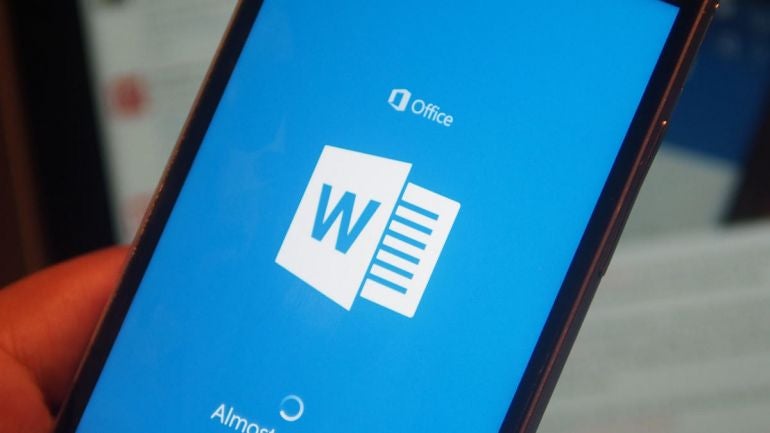
Managing uppercase and lowercase text in Word can be a challenge. Sometimes Word automatically tries to correct a word based on capitalization but makes the wrong assumption. Other times you might have an entire word or phrase in lowercase that you want to convert to uppercase, or vice versa. Word provides several options and shortcuts that can help you more easily change and control the capitalization of text. Here’s how they work.
SEE: 83 Excel tips every user should master (TechRepublic)
For this article, I’m working with the version of Word from Microsoft 365. But the tips here apply to any desktop version of Word from the past few years though not to the free online edition.
By default, Word automatically capitalizes words in a certain context, such as those at the beginning of a sentence or the days of the week. If you’d prefer to handle the capitalization yourself, you can control these options. From Word, click the File menu and select Options. At the Word Options window, select the Proofing category and click the button for AutoCorrect Options (Figure A).
Figure A
Make sure the AutoCorrect tab is selected. Here, you can check or uncheck several options for capitalization. The first option automatically changes the second letter in a word from uppercase to lowercase if you type two uppercase characters in a row.
The next three options control capitalization for the first letter in a sentence, the first letter in a table cell, and the first letter in a day of the week.
The fifth option changes the appropriate letters in a word from uppercase to lowercase if you accidentally press the Caps Lock key and then turn it off in the middle of typing the word.
Experiment with some of these settings turned on and off to see whether the autocorrect feature helps you or gets in your way (Figure B).
Figure B
If you wish to keep all or most of these autocorrect settings enabled but don’t want certain words automatically changed, just add them as exceptions. To do this, click the Exceptions button.
The first section for First Letter will not change the first letter from lowercase to uppercase for any entries. Scroll down the list to see the existing entries. Select any you want to delete and click Remove. Type a new word or term that you want to include in the list and click Add (Figure C).
Figure C
The second section for Initial Caps will not change the second letter in a word from uppercase to lowercase if the first two letters are uppercase. Again, select any existing entries you want to remove. Type any words or terms you want to include and click Add (Figure D).
Figure D
The third section for Other Corrections applies to any words that don’t fit the first two sections. Type a word or words you wish to include and click Add (Figure E).
Figure E
When finished, keep clicking OK until you’ve closed all the Word Options windows and are back at your document.
Next, you can quickly change a word from lowercase to uppercase or vice versa. Place your cursor anywhere in a word whose case you want to change. If you need to change the case for multiple words, select them all. Click the Home menu and then click the Change Case button on the Ribbon (the one with the Aa symbol).
The button displays a menu with five options: Sentence case changes the word’s capitalization to match that of the overall sentence. Lowercase changes all the letters in the word to lowercase. Uppercase changes all the letters in the word to uppercase. Capitalize each word capitalizes only the first letter of the word or words. Toggle Case changes each individual letter in the word from uppercase to lowercase, or vice versa (Figure F).
Figure F
Finally, you can more quickly change the case of a word or words through a keyboard shortcut. Place your cursor in the word you want to change or select multiple words. Hold down the Shift key and press F3. Press F3 again and then again. As you press F3, Word cycles through three different capitalization modes: all uppercase, all lowercase, and first letters uppercase. Release the key when you’ve applied your desired capitalization (Figure G).
Figure G
Has this ever happened to you? You’re plugging along on a Microsoft Word document only to freeze because you can’t recall how to do a relatively simple formatting function. I think it’s happened to all of us at one point or another and I hope the following will be your go-to resource whenever an instance like that takes place. (Bookmark the link so you can easily find it whenever a brain freeze occurs!)
My goal is not to cover all Microsoft Word formatting capabilities, just the basic ones that can increase your efficiency greatly. If you need more information or other guidance, look to the ‘HELP’ feature within the software itself.
How do I capitalize (or uncapitalize) text in microsoft Word?
You can change the capitalization, or case, of selected text in a document by clicking a single button on the Home tab called Change Case.
To change capitalization (or case) in Word, follow these steps:
- Select the text for which you want to change the case.
- On the Home tab, in the Font group, click the Change Case button.
- Then choose one of the following:
- To capitalize the first letter of a sentence and leave all other letters as lowercase, click Sentence case.
- To exclude capital letters from your text, click lowercase.
- To capitalize all of the letters, click UPPERCASE.
- To capitalize the first letter of each word and leave the other letters lowercase, click Capitalize Each Word.
- To shift between two case views (for example, to shift between Capitalize Each Word and the opposite, cAPITALIZE eACH wORD), click tOGGLE cASE.
To apply small capital (Small Caps) to your text:
- Select the text, and then on the Home tab, in the Font group, click the Font Dialog Box Launcher (the arrow in the lower-right corner). In the Font dialog box, under Effects, select the Small Caps checkbox.
To use a keyboard shortcut to change between lowercase, UPPERCASE, and Capitalize Each Word:
- Select the text and press SHIFT + F3 until the case you want is applied.
How do I add text effects in a Word document?
Besides WordArt and color fills and outlines, you can change the look of your text by adding effects, such as shadows, reflections, or glows.
To add text effects in Word, do the following:
- Select the text to which you want to add an effect.
- On the Home tab, in the Font group, click the Text Effect button.
- Point to the effect that you want (Shadow, Reflection, or Glow) and then when more choices appear click the effect that you want to add.
NOTE: To remove an effect, click the Clear Formatting button (eraser) on the Home tab in the Font group.
How do I change or set the default font in microsoft word?
The default font for new documents in Word 2016 is Calibri, 11 point but you can change/set it to your preference.
NOTE: When you set a default font, every new document you open will use the font settings that you selected and set as the default. The default font applies to new documents based on the active template, usually Normal.dotm.
To change/set the default in Word, follow these steps:
- Start with a blank document, or if your document already contains text formatted with the properties that you want to use, select that text.
- On the Home tab, click the Font Dialog Box Launcher, and then click the Font tab.
- Select the options that you want to apply to the default font, such as font style and font size. NOTE: If you selected text in step 1, the properties of the selected text are already set in the dialog box.
- Click Set As Default, and set the scope of your changes:
- This document only: (if you want your changes to apply to only the current document)
- Select all documents based on the Normal template: (if you want your changes to apply to any document based on the Normal template)
- Click OK to apply your changes.
How do I format paragraphs in word?
To change spacing between paragraphs in Word, do this:
- Click Design, then Paragraph Spacing.
- Pick which spacing you want (the default is Open) and notice your whole document will preview as you mouse over the different settings.
- If you do not like those options, click Custom Paragraph Spacing and change the numbers under Paragraph Spacing.
To change the spacing in only part of a document:
- Click anywhere in the paragraph you want to change.
- Go to Page Layout and under Spacing, click the up or down arrows to adjust the distance before or after the paragraph. You can also type a number directly.
To format a Word document with columns, follow these steps:
- Select the text you want formatted in columns.
- On the Layout tab, click Columns.
- Click More Columns.
- Click the number of columns that you want.
- Optional: To add a vertical line between the columns, select the Line Between checkbox. You can also adjust the column width and spacing.
- In the Apply to list, click Whole Document, Selected Text or This Point Forward.
To control how text flows between columns:
- Insert a column break. For example, to end a paragraph in one column and start a new paragraph at the top of the next column.
To Stop Using Columns:
- On the Layout tab, click Columns and then click One to return to one-column format. NOTE: You may need to insert a section break if you want two-columns in one section of your document and one-column formatting in another section of the document.
To add leaders between tab stops in Word, do this:
Leaders are those special characters—dots, dashes, underlines—that create a visual link between tab stops. Most often, you see leaders in a table of contents or an index.
NOTE: If you want to use tab stops and leaders to format a Table of Contents, consider using Word to create one automatically.
- Type the text that you want to appear before the leader.
- On the horizontal ruler, set the tab stop where you want (just click on the ruler), and then double-click it.
- In the Tabs dialog box under Leader, choose none, dots, dashes, or underline to set a series of characters.
- Click OK, and then press Tab on your keyboard.
- Type the text that you want to appear after the leader.
If you’d like to dive deeper into the formatting tools of Microsoft Word, and other applications within the Microsoft Office Suite, sign up for a one-day training class at Centriq.
View Centriq’s Microsoft Office Training Classes
Get specific information by speaking with a Training Advisor by email, by phone at 913.322.7062 and 314.644.6400, or by completing the following form.

 .
.
